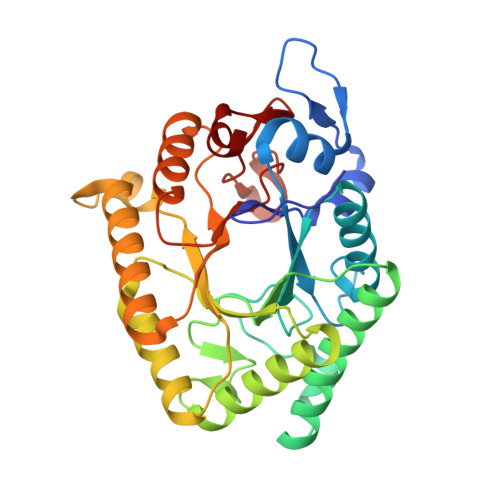Structural and functional characterization of a family GH53 beta-1,4-galactanase from Bacteroides thetaiotaomicron that facilitates degradation of prebiotic galactooligosaccharides.
Boger, M., Hekelaar, J., van Leeuwen, S.S., Dijkhuizen, L., Lammerts van Bueren, A.(2019) J Struct Biol 205: 1-10
- PubMed: 30553858
- DOI: https://doi.org/10.1016/j.jsb.2018.12.002
- Primary Citation of Related Structures:
6GP5, 6GPA - PubMed Abstract:
Galactooligosaccharides (GOS) are prebiotic compounds synthesized from lactose using bacterial enzymes and are known to stimulate growth of beneficial bifidobacteria in the human colon. Bacteroides thetaiotaomicron is a prominent human colon commensal bacterial species that hydrolyzes GOS using an extracellular Glycosyl Hydrolase (GH) family GH53 endo-galactanase enzyme (BTGH53), releasing galactose-based products for growth. Here we dissect the molecular basis for GOS activity of this B. thetaiotaomicron GH53 endo-galactanase. Elucidation of its X-ray crystal structure revealed that BTGH53 has a relatively open active site cleft which was not observed with the bacterial enzyme from Bacillus licheniformis (BLGAL). BTGH53 acted on GOS with degree of polymerization ≤3 and therefore more closely resembles activity of fungal GH53 enzymes (e.g. Aspergillus aculeatus AAGAL and Meripileus giganteus MGGAL). Probiotic lactobacilli that lack galactan utilization systems constitute a group of bacteria with relevance for a healthy (infant) gut. The strains tested were unable to use GOS ≥ DP3. However, they completely consumed GOS in the presence of BTGH53, resulting in clear stimulation of their extent of growth. The extracellular BTGH53 enzyme thus may play an important role in carbohydrate metabolism in complex microbial environments such as the human colon. It also may find application for the development of synergistic synbiotics.
Organizational Affiliation:
Microbial Physiology, Groningen Biomolecular Sciences and Biotechnology Institute (GBB), University of Groningen, Nijenborgh 7, 9747AG Groningen, The Netherlands.















